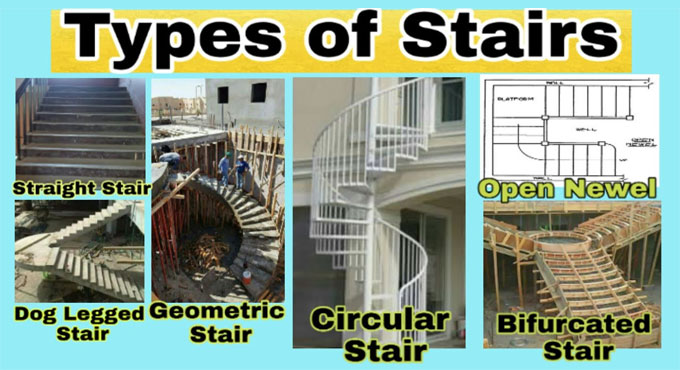
Categorization of Stairs
When deciding to build a stair, you need to know what type of stair you want to use. For this, you need to be well versed in stair terminology. Today, we will talk about the types of stairs in use throughout common building practices.
Types of Stairs
The Types of Stairs that are common in residential and commercial buildings are:
1. Straight Stairs
2. L Shaped Stairs
3. U Shaped Stairs
4. Winder Stairs
5. Spiral Stairs
6. Curved Stairs
7. Ladders
Now let us see about them in detail.
Straight stairs: Straight stairs will be stairs without any adjustments in heading. They are certainly one of the most widely recognized sorts of stairs found in both residential and commercial properties.
Below are examples of straight floating stairs made with an assortment of stringer styles, railing types, and wood species.
Straight stairs with a central landing: On longer flights of stairs, a landing is embedded to separate the flight. Building codes require this for floor heights over 12 feet. Especially in commercial buildings, straight stairs frequently have platforms halfway up the run of the stairs.
L shaped stairs: The L shaped stair is a variety of the straight stair with a twist in some segment of the stair. This curve is usually accomplished by including a landing at the progress point. The twist is frequently 90 degrees, in any case, it doesn't need to be.
On the off chance that the landing is closer to the top or base of the stairs it is now and then alluded to as a long L stair or a quarter turn stair.
U Shaped Stair: U shaped stairs are essentially two parallel flights of straight stairs joined by a landing that makes a 180-degree turn in the walk line.
Winder Stair: Winder stairs are a variety of a L shaped stair but rather than a flat landing, they have pie-shaped or triangular strides at the corner progress. The main advantage of winder stairs is that they require less space than many other types of stairs. They are very common in older homes and often used as a secondary staircase.
Spiral Stair: Spiral stairs follow a helical bend. They usually have a minimized design and the tracks transmit around a central pole. One of the key advantages of spiral stairs is their compactness.
They are very popular on beach front decks where space is at a premium. They are also used extensively on city lofts for the same reason.
Curved Stair: Like spiral stairs, curved stairs follow a helical circular segment. In any case, they will in general have a much larger radius and typically don't make a full circle. Curved stairs add elegance to any home or business.
Consequently, they are almost always located at the section where they establish the best first connection.
Ladders: Ladders, like stairs, can fill in as a method to get to. In any case, building codes don't allow ladders to fill in as an essential method for getting to. An engineer can design custom ladders for applications such as libraries, lofts, and docks.


